Yujia Chen
On the Adaptive Psychological Persuasion of Large Language Models
Jun 07, 2025Abstract:Previous work has showcased the intriguing capabilities of Large Language Models (LLMs) in instruction-following and rhetorical fluency. However, systematic exploration of their dual capabilities to autonomously persuade and resist persuasion, particularly in contexts involving psychological rhetoric, remains unexplored. In this paper, we first evaluate four commonly adopted LLMs by tasking them to alternately act as persuaders and listeners in adversarial dialogues. Empirical results show that persuader LLMs predominantly employ repetitive strategies, leading to low success rates. Then we introduce eleven comprehensive psychological persuasion strategies, finding that explicitly instructing LLMs to adopt specific strategies such as Fluency Effect and Repetition Effect significantly improves persuasion success rates. However, no ``one-size-fits-all'' strategy proves universally effective, with performance heavily dependent on contextual counterfactuals. Motivated by these observations, we propose an adaptive framework based on direct preference optimization that trains LLMs to autonomously select optimal strategies by leveraging persuasion results from strategy-specific responses as preference pairs. Experiments on three open-source LLMs confirm that the proposed adaptive psychological persuasion method effectively enables persuader LLMs to select optimal strategies, significantly enhancing their success rates while maintaining general capabilities. Our code is available at https://github.com/KalinaEine/PsychologicalPersuasion.
Imaging for All-Day Wearable Smart Glasses
Apr 17, 2025Abstract:In recent years smart glasses technology has rapidly advanced, opening up entirely new areas for mobile computing. We expect future smart glasses will need to be all-day wearable, adopting a small form factor to meet the requirements of volume, weight, fashionability and social acceptability, which puts significant constraints on the space of possible solutions. Additional challenges arise due to the fact that smart glasses are worn in arbitrary environments while their wearer moves and performs everyday activities. In this paper, we systematically analyze the space of imaging from smart glasses and derive several fundamental limits that govern this imaging domain. We discuss the impact of these limits on achievable image quality and camera module size -- comparing in particular to related devices such as mobile phones. We then propose a novel distributed imaging approach that allows to minimize the size of the individual camera modules when compared to a standard monolithic camera design. Finally, we demonstrate the properties of this novel approach in a series of experiments using synthetic data as well as images captured with two different prototype implementations.
Probing then Editing Response Personality of Large Language Models
Apr 14, 2025Abstract:Large Language Models (LLMs) have demonstrated promising capabilities to generate responses that exhibit consistent personality traits. Despite the major attempts to analyze personality expression through output-based evaluations, little is known about how such traits are internally encoded within LLM parameters. In this paper, we introduce a layer-wise probing framework to systematically investigate the layer-wise capability of LLMs in encoding personality for responding. We conduct probing experiments on 11 open-source LLMs over the PersonalityEdit benchmark and find that LLMs predominantly encode personality for responding in their middle and upper layers, with instruction-tuned models demonstrating a slightly clearer separation of personality traits. Furthermore, by interpreting the trained probing hyperplane as a layer-wise boundary for each personality category, we propose a layer-wise perturbation method to edit the personality expressed by LLMs during inference. Our results show that even when the prompt explicitly specifies a particular personality, our method can still successfully alter the response personality of LLMs. Interestingly, the difficulty of converting between certain personality traits varies substantially, which aligns with the representational distances in our probing experiments. Finally, we conduct a comprehensive MMLU benchmark evaluation and time overhead analysis, demonstrating that our proposed personality editing method incurs only minimal degradation in general capabilities while maintaining low training costs and acceptable inference latency. Our code is publicly available at https://github.com/universe-sky/probing-then-editing-personality.
MIND: Towards Immersive Psychological Healing with Multi-agent Inner Dialogue
Feb 27, 2025Abstract:Mental health issues are worsening in today's competitive society, such as depression and anxiety. Traditional healings like counseling and chatbots fail to engage effectively, they often provide generic responses lacking emotional depth. Although large language models (LLMs) have the potential to create more human-like interactions, they still struggle to capture subtle emotions. This requires LLMs to be equipped with human-like adaptability and warmth. To fill this gap, we propose the MIND (Multi-agent INner Dialogue), a novel paradigm that provides more immersive psychological healing environments. Considering the strong generative and role-playing ability of LLM agents, we predefine an interactive healing framework and assign LLM agents different roles within the framework to engage in interactive inner dialogues with users, thereby providing an immersive healing experience. We conduct extensive human experiments in various real-world healing dimensions, and find that MIND provides a more user-friendly experience than traditional paradigms. This demonstrates that MIND effectively leverages the significant potential of LLMs in psychological healing.
KPIs 2024 Challenge: Advancing Glomerular Segmentation from Patch- to Slide-Level
Feb 11, 2025Abstract:Chronic kidney disease (CKD) is a major global health issue, affecting over 10% of the population and causing significant mortality. While kidney biopsy remains the gold standard for CKD diagnosis and treatment, the lack of comprehensive benchmarks for kidney pathology segmentation hinders progress in the field. To address this, we organized the Kidney Pathology Image Segmentation (KPIs) Challenge, introducing a dataset that incorporates preclinical rodent models of CKD with over 10,000 annotated glomeruli from 60+ Periodic Acid Schiff (PAS)-stained whole slide images. The challenge includes two tasks, patch-level segmentation and whole slide image segmentation and detection, evaluated using the Dice Similarity Coefficient (DSC) and F1-score. By encouraging innovative segmentation methods that adapt to diverse CKD models and tissue conditions, the KPIs Challenge aims to advance kidney pathology analysis, establish new benchmarks, and enable precise, large-scale quantification for disease research and diagnosis.
SEAL: Semantic Attention Learning for Long Video Representation
Dec 02, 2024Abstract:Long video understanding presents challenges due to the inherent high computational complexity and redundant temporal information. An effective representation for long videos must process such redundancy efficiently while preserving essential contents for downstream tasks. This paper introduces SEmantic Attention Learning (SEAL), a novel unified representation for long videos. To reduce computational complexity, long videos are decomposed into three distinct types of semantic entities: scenes, objects, and actions, allowing models to operate on a handful of entities rather than a large number of frames or pixels. To further address redundancy, we propose an attention learning module that balances token relevance with diversity formulated as a subset selection optimization problem. Our representation is versatile, enabling applications across various long video understanding tasks. Extensive experiments show that SEAL significantly outperforms state-of-the-art methods in video question answering and temporal grounding tasks and benchmarks including LVBench, MovieChat-1K, and Ego4D.
Semantic Image Inversion and Editing using Rectified Stochastic Differential Equations
Oct 14, 2024
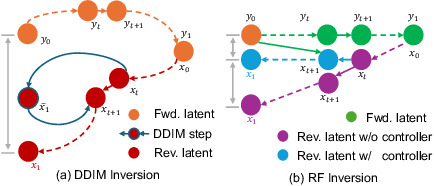

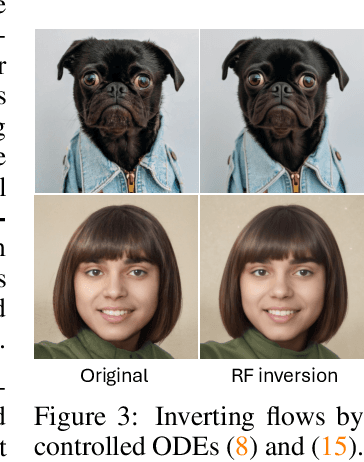
Abstract:Generative models transform random noise into images; their inversion aims to transform images back to structured noise for recovery and editing. This paper addresses two key tasks: (i) inversion and (ii) editing of a real image using stochastic equivalents of rectified flow models (such as Flux). Although Diffusion Models (DMs) have recently dominated the field of generative modeling for images, their inversion presents faithfulness and editability challenges due to nonlinearities in drift and diffusion. Existing state-of-the-art DM inversion approaches rely on training of additional parameters or test-time optimization of latent variables; both are expensive in practice. Rectified Flows (RFs) offer a promising alternative to diffusion models, yet their inversion has been underexplored. We propose RF inversion using dynamic optimal control derived via a linear quadratic regulator. We prove that the resulting vector field is equivalent to a rectified stochastic differential equation. Additionally, we extend our framework to design a stochastic sampler for Flux. Our inversion method allows for state-of-the-art performance in zero-shot inversion and editing, outperforming prior works in stroke-to-image synthesis and semantic image editing, with large-scale human evaluations confirming user preference.
RB-Modulation: Training-Free Personalization of Diffusion Models using Stochastic Optimal Control
May 27, 2024
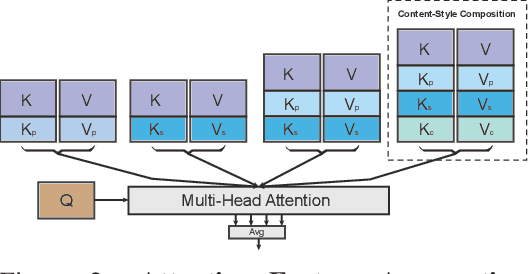

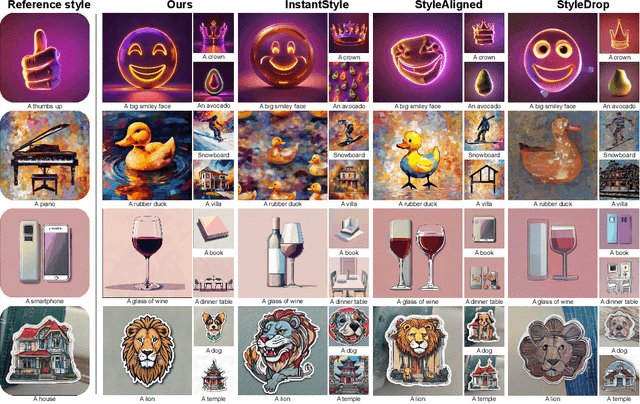
Abstract:We propose Reference-Based Modulation (RB-Modulation), a new plug-and-play solution for training-free personalization of diffusion models. Existing training-free approaches exhibit difficulties in (a) style extraction from reference images in the absence of additional style or content text descriptions, (b) unwanted content leakage from reference style images, and (c) effective composition of style and content. RB-Modulation is built on a novel stochastic optimal controller where a style descriptor encodes the desired attributes through a terminal cost. The resulting drift not only overcomes the difficulties above, but also ensures high fidelity to the reference style and adheres to the given text prompt. We also introduce a cross-attention-based feature aggregation scheme that allows RB-Modulation to decouple content and style from the reference image. With theoretical justification and empirical evidence, our framework demonstrates precise extraction and control of content and style in a training-free manner. Further, our method allows a seamless composition of content and style, which marks a departure from the dependency on external adapters or ControlNets.
Beyond First-Order Tweedie: Solving Inverse Problems using Latent Diffusion
Dec 01, 2023
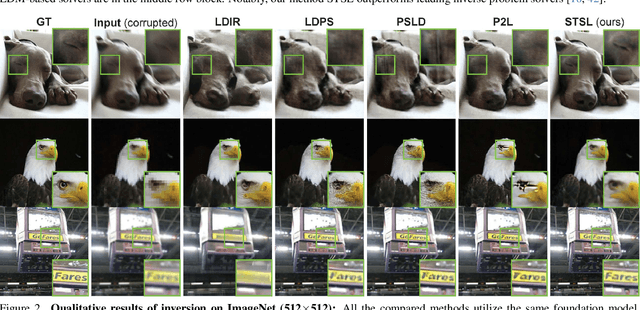
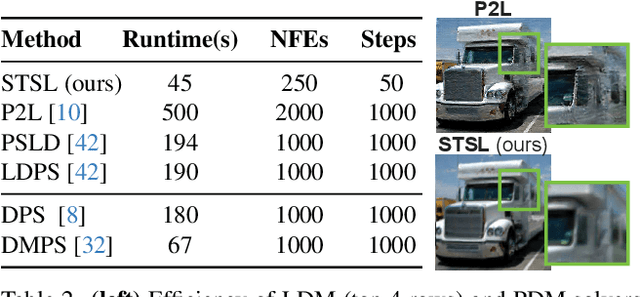
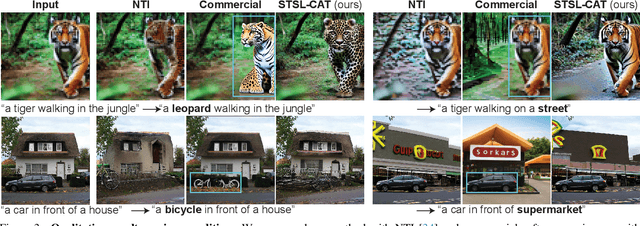
Abstract:Sampling from the posterior distribution poses a major computational challenge in solving inverse problems using latent diffusion models. Common methods rely on Tweedie's first-order moments, which are known to induce a quality-limiting bias. Existing second-order approximations are impractical due to prohibitive computational costs, making standard reverse diffusion processes intractable for posterior sampling. This paper introduces Second-order Tweedie sampler from Surrogate Loss (STSL), a novel sampler that offers efficiency comparable to first-order Tweedie with a tractable reverse process using second-order approximation. Our theoretical results reveal that the second-order approximation is lower bounded by our surrogate loss that only requires $O(1)$ compute using the trace of the Hessian, and by the lower bound we derive a new drift term to make the reverse process tractable. Our method surpasses SoTA solvers PSLD and P2L, achieving 4X and 8X reduction in neural function evaluations, respectively, while notably enhancing sampling quality on FFHQ, ImageNet, and COCO benchmarks. In addition, we show STSL extends to text-guided image editing and addresses residual distortions present from corrupted images in leading text-guided image editing methods. To our best knowledge, this is the first work to offer an efficient second-order approximation in solving inverse problems using latent diffusion and editing real-world images with corruptions.
JIANG: Chinese Open Foundation Language Model
Aug 01, 2023
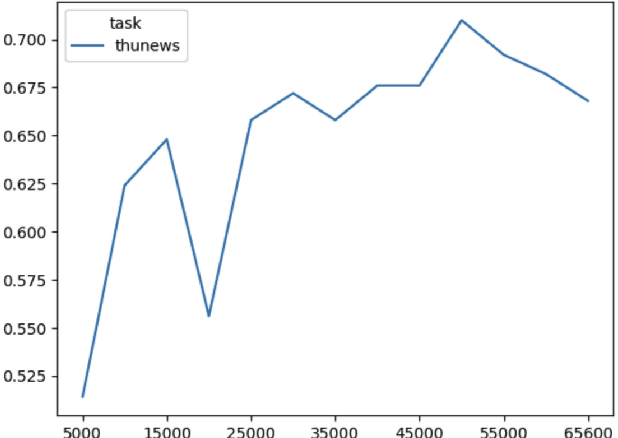


Abstract:With the advancements in large language model technology, it has showcased capabilities that come close to those of human beings across various tasks. This achievement has garnered significant interest from companies and scientific research institutions, leading to substantial investments in the research and development of these models. While numerous large models have emerged during this period, the majority of them have been trained primarily on English data. Although they exhibit decent performance in other languages, such as Chinese, their potential remains limited due to factors like vocabulary design and training corpus. Consequently, their ability to fully express their capabilities in Chinese falls short. To address this issue, we introduce the model named JIANG (Chinese pinyin of ginger) specifically designed for the Chinese language. We have gathered a substantial amount of Chinese corpus to train the model and have also optimized its structure. The extensive experimental results demonstrate the excellent performance of our model.
 Add to Chrome
Add to Chrome Add to Firefox
Add to Firefox Add to Edge
Add to Edge